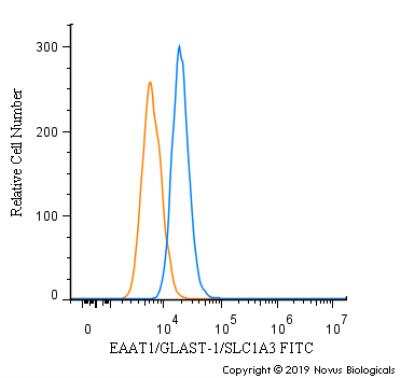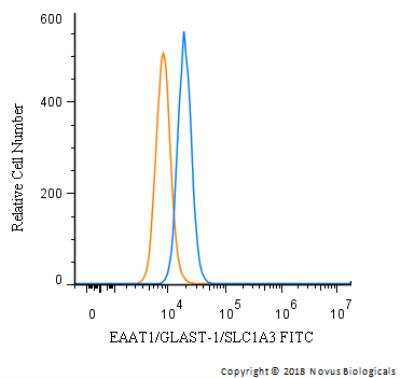EAAT1/GLAST-1/SLC1A3 Antibody [FITC]
Novus Biologicals, part of Bio-Techne | Catalog # NB100-1869F


Conjugate
Catalog #
Forumulation
Catalog #
Key Product Details
Species Reactivity
Validated:
Human, Mouse, Rat
Predicted:
Bovine (100%). Backed by our 100% Guarantee.
Applications
ELISA, Flow (Intracellular), Flow Cytometry, Immunocytochemistry/ Immunofluorescence, Immunohistochemistry, Immunohistochemistry-Frozen, Immunohistochemistry-Paraffin, Western Blot
Label
FITC (Excitation = 495 nm, Emission = 519 nm)
Antibody Source
Polyclonal Rabbit IgG
Concentration
Please see the vial label for concentration. If unlisted please contact technical services.
Product Specifications
Immunogen
A synthetic peptide made to a C-terminal portion of the rat SLC1A3 protein (between residues 500-542)
Localization
Membrane and ER
Clonality
Polyclonal
Host
Rabbit
Isotype
IgG
Scientific Data Images for EAAT1/GLAST-1/SLC1A3 Antibody [FITC]
Flow Cytometry: EAAT1/GLAST-1/SLC1A3 Antibody [FITC] [NB100-1869F] - An intracellular stain was performed on Caco-2 cells with EAAT1/GLAST-1/SLC1A3 Antibody NB100-1869F (blue) and a matched isotype control (orange). Cells were fixed with 4% PFA and then permeabilized with 0.1% saponin. Cells were incubated in an antibody dilution of 10 ug/mL for 30 minutes at room temperature. Both antibodies were conjugated to FITC.
Flow Cytometry: EAAT1/GLAST-1/SLC1A3 Antibody [FITC] [NB100-1869F] - An intracellular stain was performed on HeLa cells with EAAT1/GLAST-1/SLC1A3 Antibody NB100-1869F (blue) and a matched isotype control (orange). Cells were fixed with 4% PFA and then permeabilized with 0.1% saponin. Cells were incubated in an antibody dilution of 10 ug/mL for 30 minutes at room temperature. Both antibodies were conjugated to FITC.
Applications for EAAT1/GLAST-1/SLC1A3 Antibody [FITC]
Application
Recommended Usage
ELISA
Optimal dilutions of this antibody should be experimentally determined.
Flow (Intracellular)
Optimal dilutions of this antibody should be experimentally determined.
Flow Cytometry
Optimal dilutions of this antibody should be experimentally determined.
Immunocytochemistry/ Immunofluorescence
Optimal dilutions of this antibody should be experimentally determined.
Immunohistochemistry
Optimal dilutions of this antibody should be experimentally determined.
Immunohistochemistry-Frozen
Optimal dilutions of this antibody should be experimentally determined.
Immunohistochemistry-Paraffin
Optimal dilutions of this antibody should be experimentally determined.
Western Blot
Optimal dilutions of this antibody should be experimentally determined.
Application Notes
Optimal dilution of this antibody should be experimentally determined.
Formulation, Preparation, and Storage
Purification
Immunogen affinity purified
Formulation
PBS
Preservative
0.05% Sodium Azide
Concentration
Please see the vial label for concentration. If unlisted please contact technical services.
Shipping
The product is shipped with polar packs. Upon receipt, store it immediately at the temperature recommended below.
Stability & Storage
Store at 4C in the dark.
Background: EAAT1/GLAST-1
Long Name
Excitatory Amino Acid Transporter 1/Sodium-dependent Glu/Asp Transporter 1
Alternate Names
EA6, GLAST-1, GLAST1, SLC1A3
Gene Symbol
SLC1A3
Additional EAAT1/GLAST-1 Products
Product Documents for EAAT1/GLAST-1/SLC1A3 Antibody [FITC]
Product Specific Notices for EAAT1/GLAST-1/SLC1A3 Antibody [FITC]
This product is for research use only and is not approved for use in humans or in clinical diagnosis. Primary Antibodies are guaranteed for 1 year from date of receipt.
